
The New World leaf-nosed bats (Phyllostomidae) are found from southern North America to South America, specifically from the Southwest United States to northern Argentina. They are ecologically the most varied and diverse family within the order Chiroptera. Most species are insectivorous, but the phyllostomid bats include within their number true predatory species and frugivores. For example, the spectral bat, the largest bat in the Americas, eats vertebrate prey, including small, dove-sized birds. Members of this family have evolved to use food groups such as fruit, nectar, pollen, insects, frogs, other bats, and small vertebrates, and in the case of the vampire bats, even blood.

The long-tongued nectar bat, also known as the northern blossom bat, honey nectar bat, least blossom-bat, dagger-toothed long-nosed fruit bat, and lesser long-tongued fruit bat, is a species of megabat. M. minimus is one of the smallest species in the family Pteropodidae, with an average length of 60–85 mm. It has a reddish-brown colouring with relatively long hair compared to the other species. The hair on the abdomen is a lighter colour, and a dark brown stripe runs bilaterally down the top of the head and back.
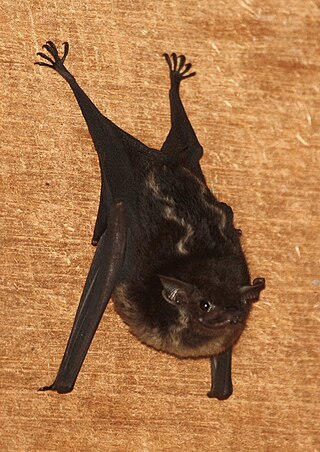
The greater sac-winged bat is a bat of the family Emballonuridae native to Central and South America.

The tailed tailless bat is a species of leaf-nosed bat from South America.
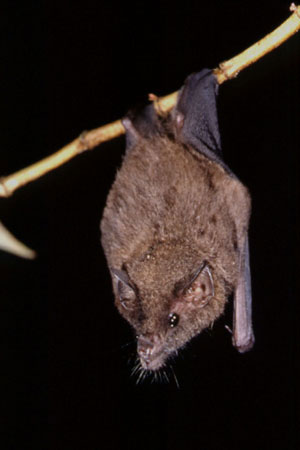
Geoffroy's tailless bat is a species of phyllostomid bat from the American tropics.
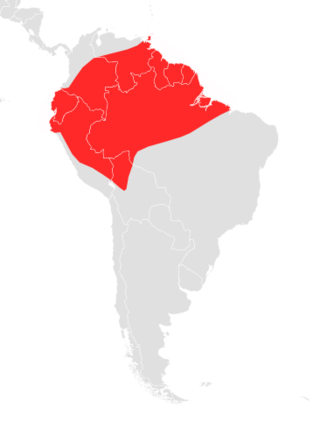
The lesser long-tongued bat, also called the lesser long-tailed bat, is a bat species from South America.

The dark long-tongued bat is a species of bat from South and Central America. It was formerly considered the only species within the genus Lichonycteris, but is now recognized as one of two species in that genus, along with the pale brown long-nosed bat. It is small species of bat, with adults weighing 6–11 g (0.21–0.39 oz) and having a total length of 46–63 mm (1.8–2.5 in).
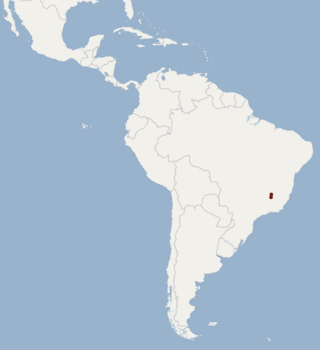
Bokermann's nectar bat is a bat species from South America. It is endemic to Brazil. It feeds on nectar, and is listed as an endangered species.

The tent-making bat is an American leaf-nosed bat (Phyllostomidae) found in lowland forests of Central and South America. This medium-sized bat has a gray coat with a pale white stripe running down the middle of the back. Its face is characterized by a fleshy noseleaf and four white stripes. Primarily a frugivore, it may supplement its diet with insects, flower parts, pollen, and nectar. Its common name comes from its curious behavior of constructing tents out of large, fan-shaped leaves. These roosts provide excellent protection from the tropical rains, and a single tent roost may house several bats at once. This bat is quite common in its geographic range; hence, its conservation status is listed as Least Concern.

Anoura is a genus of leaf-nosed bats from Central and South America. Anoura members lack or have a short tail, and are nectarivorous bats of small to medium size among the Phyllostomidae.

The Mexican long-tongued bat is a species of bat in the family Phyllostomidae. It is the only species within the genus Choeronycteris. The species is found in El Salvador, Guatemala, Honduras, Mexico, and the United States.

Leach's single leaf bat, also known as Greater Antillean long-tongued bat, is a species of bat in the family Phyllostomidae. It is found in the southern Bahamas and in all the Greater Antilles. It forms large colonies, with up to a few hundred thousand individuals, and feeds on a relatively wide variety of food items including pollen, nectar, fruit and insects.

The banana bat is an endangered species of bat in the family Phyllostomidae. It is also commonly known as the trumpet-nosed bat or the Colima long-nosed bat.

The Jamaican flower bat is a critically endangered species of bat in the family Phyllostomidae. It is endemic to Jamaica.
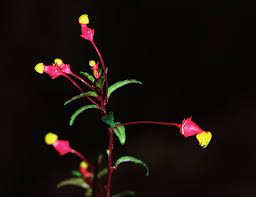
Burmeistera is a genus of flowering plants in the bellflower family, Campanulaceae. There are around 130 species distributed in Central and South America. This genus represents a rapid evolutionary radiation with species having diverged within only the last 2.6 million years.

Glossophaginae is a subfamily of leaf-nosed bats.

Anoura peruana is a species of bat from Colombia and Peru. It was elevated to a species in 2010, after previously being considered a subspecies of Geoffroy's tailless bat. The females are larger than the males.

Cadena's tailless bat is a species of bat native to Colombia. In 2006 it was described as a separate species from the tailed tailless bat species complex.

Anoura aequatoris is a species of microbat that lives in South America in the countries of Bolivia, Colombia, Ecuador, and Peru.


















